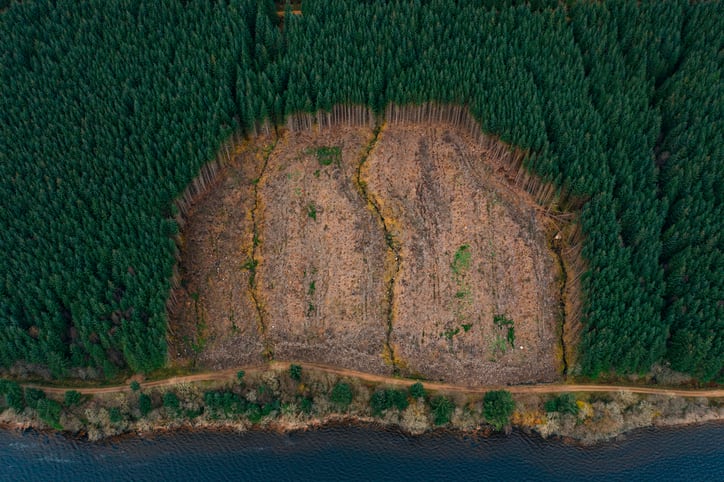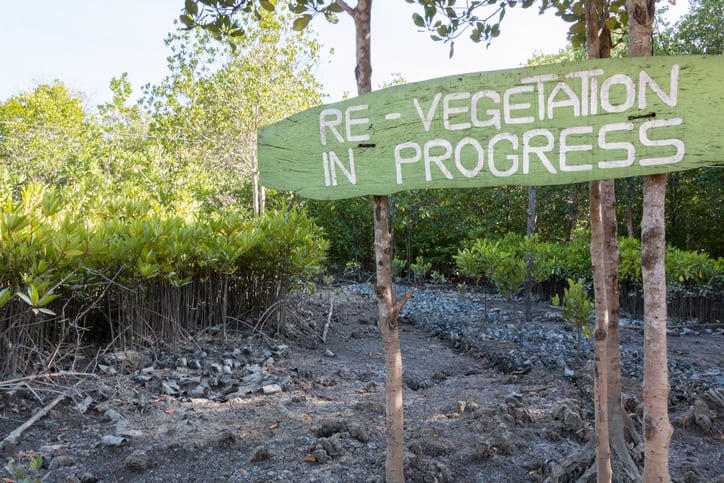Many food and beverage companies rely on carbon offsetting – or buying carbon credits that fund deforestation, renewable energy or tree-planting projects – to compensate for emissions they cannot remove within their own operations. The voluntary carbon market, which sells credits to the corporate world, insists that carbon offsets remain a key part of the race to zero.
But most carbon offset schemes to prevent deforestation are significantly overestimating their effectiveness, claims a study published in Science.
An international team of scientists and economists led by the University of Cambridge and VU Amsterdam looked at 18 REDD+ projects in Peru, Colombia, Cambodia, Tanzania and the Democratic Republic of Congo.
REDD+ projects are overseen by the UN and aim to slow deforestation by, for example, helping farmers to change their practices. They generate credits by estimating the amount of deforestation saved thanks to the project.
To investigate their deforestation impact, the researchers analysed similar areas of forest not part of the REDD+ projects. They concluded that the 18 offsetting projects had produced millions of carbon credits based on ‘crude calculations that inflated their conservation impact’.
Of a potential 89 million credits from these offset schemes, only 5.4 million (6%) were linked to additional carbon reductions through preserved forest. Over 60 million carbon credits came from projects that barely reduced deforestation, if at all.
“These projects have already been used to offset almost three times more carbon emissions than their actual contributions to climate change mitigation,” the researchers concluded, adding this ratio will likely get worse as most of the credits generated by these schemes have yet to be sold.
Carbon credit markets have exploded in recent years. Over 150 million credits originated from voluntary REDD+ projects in 2021, with a value of US $1.3 billion. But some companies use carbon offsetting to claim progress towards ‘net zero’ while doing little to reduce greenhouse gases, said the researchers.
They argue that the booming trade in carbon credits may already be a type of ‘lemons market’ – where buyers have no way of distinguishing quality, so some sellers flood the market with bad products, leading to a breakdown of trust and ultimately market collapse.
“Carbon credits provide major polluters with some semblance of climate credentials. Yet we can see that claims of saving vast swathes of forest from the chainsaw to balance emissions are overblown,” said study senior author Prof Andreas Kontoleon, from Cambridge’s Department of Land Economy.
“These carbon credits are essentially predicting whether someone will chop down a tree, and selling that prediction. If you exaggerate or get it wrong, intentionally or not, you are selling hot air.”
Overestimations of forest preservation have allowed the number of carbon credits on the market to keep rising, which in turn supresses the prices, he added. “Potential buyers benefit from consistently low prices created by the flood of credits. It means that companies can tick their net zero box at the lowest possible cost.”
Why might carbon credit schemes be overestimating their effectiveness so dramatically?
Historical trends are simply highly inaccurate, the researchers said. Projects may also be located where conservation is most likely to succeed regardless. Certification rules currently require fixed periods for projections, so adapting to changes in deforestation rates is difficult.
Lastly, methods of predicting deforestation may be “opportunistically inflated” to maximise revenues from credit sales, the researchers warned.
“There are perverse incentives to generate huge numbers of carbon credits, and at the moment the market is essentially unregulated. Watchdog agencies are being created, but many of those involved are also linked to carbon credit certification agencies – so they will be marking their own homework,” added Kontoleon.
“The industry needs to work on closing loopholes that might allow bad faith actors to exploit offset markets. It must develop far more sophisticated and transparent methods of quantifying the amount of preserved forest to become a trusted marketplace.”
Implications for future investment?
In an accompanying editorial Julia Jones, from Bangor University, and Simon Lewis, from Leeds University, said the implications of the study’s findings are far reaching. “Misleading offsets carry negative consequences for the climate because they are not offsetting the emissions release, for forest conservation because they are not reducing deforestation as much as claimed, and for the future finance of forest conservation because the reputational risks of being tainted by accusations of greenwash may deter future investments.”
The study comes as attitudes in the food and beverage industry shift towards the use of offsets. There are fears about their effectiveness; of potential consumer backlash and accusations of greenwash. Nestle, for example, wants to reduce its reliance on offsets to meet its net zero targets.
But companies with net zero targets will have to rely on them to some extent to compensate for carbon dioxide or other greenhouse gas emissions they cannot remove within their own operations.
So what’s the message for food and beverage companies in light of this latest study?
“Offsetting could work if done properly,” said lead author Dr Thales West, a Fellow of the Centre for Environment, Energy and Natural Resource Governance at Cambridge, now based at VU Amsterdam.
But it is complex to get it right, and the current way that carbon accounting protocols were designed is one of the main problems. “It requires the right training and the right experience, which is often lacking among self-proclaimed experts,” he told FoodNavigator. “There is also an incentive for projects to overestimate their baselines – how much carbon emissions would have happened in the absence of the projects – since the more pessimistic those baselines are, the more credits can be issued, and more money can be made.”
If you use offsets “make sure you really know if the behind-the-scenes calculations are solid, the claims are credible, and the on-the-ground activities are effective,” he said. “That is not an easy task, especially if you are taking advise from untrained/unexperienced self-proclaimed experts.”
Insetting – or bringing in carbon reduction processes in-house – could a more reliable way of making sure you can achieve credible emission reductions, he added, since, in theory, you are in control of the whole process. “But again, only if you are doing it right.”
Finally, other types of offset projects need to be looked at.
“While we don’t have any hard evidence to support this, at least from a theoretical perspective, and given the current practices, offsets from reforestation projects, specifically the ones promoting native vegetation restoration, as opposed to establishing commercial tree plantations are probably more likely to be associated with real carbon emission reductions than avoided deforestation projects – but even those need to be carefully examined.”
Reference
Action needed to make carbon offsets from forest conservation work for climate change mitigation
Science
DOI: 10.1126/science.ade3535




